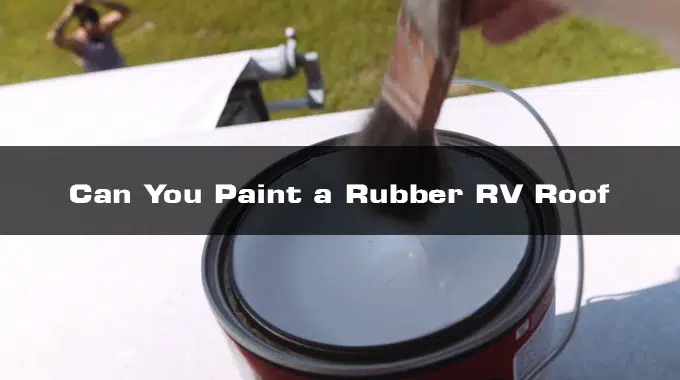Last Updated on May 1, 2023
Painting a rubber RV roof can extend its lifespan and improve its overall appearance. Proper preparation ensures that the paint or coating will withstand the elements and protect your roof from further damage.
Here, we’ll discuss the steps involved in painting a rubber RV roof, including choosing the right paint or coating and applying it correctly. We’ll also provide helpful tips on maintaining your rubber RV roof to keep it looking great for years. So, let’s get started.
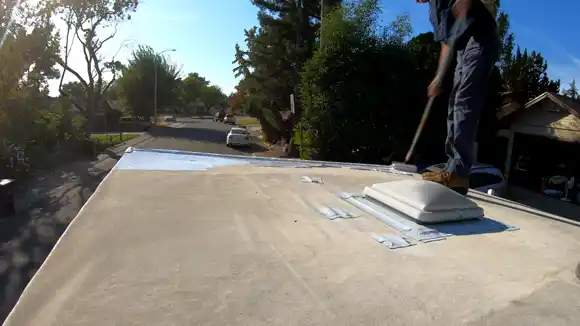
How Can You Paint a Rubber RV Roof: Simple Steps
The rubber RV roof is often a neglected part of the vehicle’s structure but can be easily painted properly. Read on to learn how to prepare a rubber RV roof for painting.
Clean the Surface
Before you can begin painting your rubber RV roof, it must be thoroughly cleaned. The best way to do this is by using an appropriate cleaner specifically designed for use on rubber roofs.
These cleaners are available from RV dealerships or online retailers and generally contain agents to help remove dirt, grime, and other debris that may have built up over time.
It is essential to scrub away any dirt, as this will affect the longevity of the paint job and its ability to adhere effectively to the roof’s surface. Once all the dirt has been removed, allow the roof to dry completely before continuing with other preparations.
Repair Any Cracks, Tears, or Damage
Once your rubber RV roof has been cleaned and dried, you must inspect it for any cracks or tears that may have occurred over time due to exposure to extreme weather conditions or other factors such as age and wear and tear.
If these are detected, they should be repaired before painting to ensure a smooth finish that won’t crack or peel off over time due to further damage caused by vibration while traveling on uneven surfaces or during extreme weather conditions such as high winds or hail storms.
Depending on the severity of damage present, this may require patching with a rubber sealant or striping with a waterproof adhesive tape product such as Eternabond RoofSeal Tape before painting preparations.
Allow Adequate Time for Drying and Curing
Once all repairs have been made, and necessary materials have been used, you must allow adequate time for everything to dry thoroughly before starting any painting process.
This is particularly important when dealing with rubber roofs since there are particular components of the material that must first dry before being painted for maximum longevity of your new paint job once completed.
Generally speaking, depending on local humidity levels, an average drying time frame can range from 24-48 hours. Still, it is recommended that you always follow the instructions provided by manufacturers to avoid any potential problems due to incomplete drying times before painting occurs.
Choosing a Paint or Coating

If you are looking for the right paint or coating for your rubber RV roof, it can be pretty challenging to decide which one is right for you; however, if you do a little research and take the time to understand the options, you can make the right choice.
We will discuss different types of paints and coatings for rubber RV roofs in this lesson and how to choose a product suitable for your particular requirements.
Acrylic-Based Paint or Sealant:
Acrylic-based paint or sealant is a great choice for rubber RV roofs because it is highly durable and water-resistant. It also resists fading, cracking, and peeling due to exposure to UV rays.
Additionally, acrylic-based paint offers excellent adhesion to most surfaces, making it easy to apply and remove when needed. Acrylic-based paint or sealant provides superior protection against corrosion and other damage caused by moisture. This type of material is also relatively inexpensive compared to other materials on the market.
Silicone-Based Paint or Sealant:
Silicone-based paint or sealant is also an excellent option for rubber RV roofs due to its high durability and resistance to water and other forms of damage. It provides superior protection against UV rays by forming a protective shield over the roof surface that helps prevent fading and cracking over time.
Additionally, silicone-based paints are better able to resist mildew growth than many other types of paints on the market. However, when applied, silicone has a strong odor that may linger even after completely drying, so proper ventilation should be ensured when using this product in enclosed areas like RVs.
Elastomeric Liquid Coating:
Elastomeric liquid coating is ideal for rubber RV roofs due to its unique properties allowing it to form a flexible membrane over any surface without adding weight or bulkiness.
This makes elastomeric liquid coating an excellent choice for softer surfaces like those found on rubber RV roofs. It is less likely than other products to crack under stress from movement or temperature changes.
Elastomeric liquid coating is highly waterproof, resistant to UV rays, and unaffected by snowfall or heavy rains. It is also very easy to apply with minimal effort required during installation.
Selecting The Right Product For Your Roof:
When choosing paint or coating for your RV roof, there are many things to think about, like how long it will last, if it will keep water away, how easy it is to put on and take off for repairs or updates, the cost and whether it helps protect against UV rays.
Also, consider if the product allows air circulation and any environmental impact. After considering all these factors, you can decide which product is best for you. If you mainly need protection from water intrusion, then an acrylic-based product would be good. But silicone-based might be better if you want something with better UV resistance.
Applying the Paint or Coating
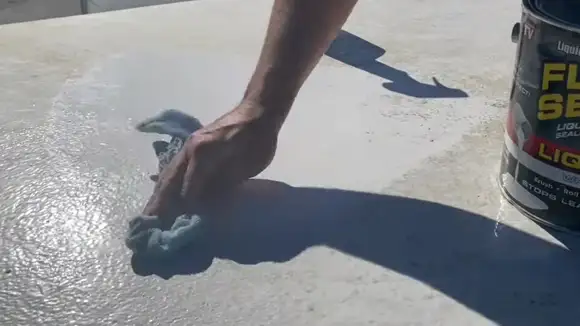
Painting a rubber RV roof is one of the most common ways to protect it from the elements and extend its life. It can be done with simple steps and precautions to ensure success. The following steps will help you paint a rubber RV roof correctly:
Safety Precautions
Taking certain safety precautions when painting or coating a rubber RV roof is essential. Safety glasses, gloves, and respirators should be worn when sanding or scraping paint off the surface, and an area free from sparks or open flames should be established.
The area should also be thoroughly ventilated so that fumes from any materials used do not accumulate indoors. Additionally, the roof should be cleared of debris before painting or coating application to ensure better product adhesion.
Preparing the Area for Painting/Coating Application
Before painting or coating can occur, it is essential to prepare the roof surface by cleaning it thoroughly with a clean cloth and water-based cleaning solution or detergent. Once cleaned, any surface cracks or crevices should be filled with sealant and allowed to dry completely before painting.
Finally, it is essential to sand down any areas that need smoothing out before applying primer or coatings to these areas. This will help ensure better adhesion of paint/coating products onto these surfaces as well as provide a smoother overall finish once all painting/coating steps are completed.
Applying Primer, if Necessary
Depending on the condition of the surface being painted/coated, the primer may need to be applied beforehand for proper adhesion of paint/coatings onto these surfaces.
Primer can help seal small openings, such as pores that may have formed due to weathering or aging on older surfaces, and aid in better adhesion of paint/coatings on newer surfaces where no existing layers are present yet that could act as barriers against new applications.
When applying primer, it is essential not to over-apply it as this could cause bubbling underneath later applications, resulting in an uneven finish after all coatings are completed.
Only enough primer needs to be applied so that all areas are covered without having too much build-up layer-wise on any single spot, especially around edges where excess build-up tends to occur more quickly due to its already more diminutive stature per unit area compared with flat regions between edges themselves.
Applying Multiple Coats of Paint/Coating
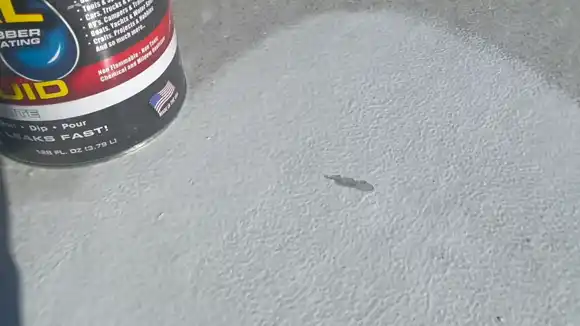
Before painting, primers need to be applied. Wait at least 24 hours between primer applications for the best results. Then, apply 2-3 coats of paint or coating according to the manufacturer’s instructions and special additives such as activators (if needed).
Spread the paint evenly without making it too thick in any spot. Puddles of paint should be avoided so that bubbles won’t form during drying. Finally, follow all steps until completion, like curing time if needed.
Maintaining Your Rubber RV Roof
Painting a Rubber RV Roof is an excellent way to maintain and protect it from the elements. Understanding the proper techniques and materials needed when painting a rubber roof and regular maintenance steps is essential to ensure a successful outcome.
Regular Cleaning and Maintenance:
Regularly cleaning your rubber RV roof is essential for avoiding premature wear and tear. First, you should use a hose to rinse any dirt or debris on the roof’s surface. Then use a soft wash brush with mild soap and water to scrub away any remaining dirt before rinsing off again with the hose.
Additionally, you should inspect your rubber roof for any tears or signs of cracking, patching these if necessary before painting. You should also look out for any moss or mildew that may have built up over time; these can be removed with a special cleaner, as your local RV dealer recommends.
Periodically Check for Cracks, Tears, and Damage:
It is also important to periodically check your rubber RV roof for any cracks, tears, or damage that may have occurred over time due to exposure to UV radiation, tree sap, or other substances, such as bird droppings, that can accelerate the aging process of your rubber roof’s surface material.
If you notice any areas of damage, then it is recommended that they are repaired before attempting to paint the roof to ensure a successful outcome. Repair kits are available at most RV stores to help repair large tears or cracks in the rubber material, which would otherwise require professional assistance.
Consider Re-Painting Every Few Years:
When considering whether or not you should paint your rubber RV roof, it is essential to understand how repainting every few years can help extend its life span and provide additional protection from harsh weather conditions, such as rain and snow, that can cause premature wear and tear over time.
Additionally, using high-quality paints specifically designed for rubber roofs will help provide maximum protection against UV radiation, which can prematurely age the surface material, thus reducing its lifespan significantly; this includes using multiple coats of sealant after painting to further protect from harsh weather conditions whenever possible.
Can You Recoat A Rubber Roof?
There is no problem with giving your rubber roof a new coating. This will help protect it from the weather and people walking on it. You must use the right liquid sealant that won’t hurt you, your family, or the environment.
First, clean the surface with a special cleaner made for rubber roofs. Then carefully apply the liquid sealant according to instructions and let it dry before using your roof again. Doing this regularly will help ensure your rubber roof stays in good condition for many years.
Can You Paint Over the Rubberized Coating?
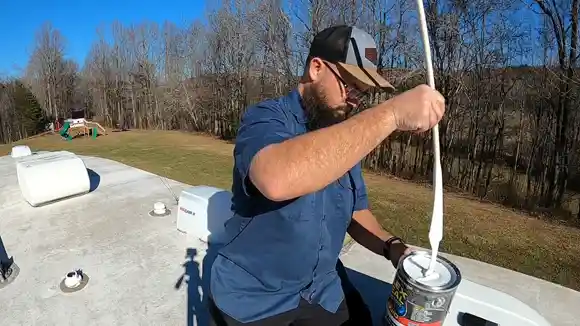
Painting over rubberized coating is possible but requires the proper preparation and techniques. The type of paint you use depends on what you’re painting and the desired outcome. Spray paint is often the best for rubber surfaces as it applies thinner, more even layers than brushes or rollers.
Krylon’s Master Paint and Primer is a popular option for painting rubber. Acrylic paint, removable paint, and urethane are also good options. Before applying any paint to rubber, cleaning the surface thoroughly is important to ensure the best results.
How Do You Get Paint To Stick To Rubber?
Painting rubber can be tricky, but it is possible with proper preparation and techniques. The best way to get paint to stick to rubber is to use an external primer before painting. This will help the paint adhere better and last longer.
Additionally, you should choose the right type of paint for your project. Acrylic craft paint works well for indoor items that won’t see much wear and tear, while spray paint is excellent for quick and easy application. For outdoor items, removable or permanent paints are recommended.
Does Flex Seal Work On RV Rubber Roofs?
Flex Seal is a great product to protect your RV’s rubber roof. Liquid rubber in a can creates an airtight seal, keeping water and moisture away from the surface. It works with other materials like fiberglass, plastic, and wood too.
Plus, it has UV protection so the sun won’t damage it. You just need to spray or brush it on your RV’s roof and let it dry then you’re done. With Flex Seal, you can ensure your roof is safe for many years.
Keep Your Rubber RV Roof Protected and Looking Great
With some patience and care, painting a rubber RV roof can be an easy and affordable way to protect it against wear and tear. Whether you opt for acrylic-based paint or silicone-based sealant, follow proper preparation instructions for maximum results.
Regular cleaning and maintenance will help keep your rubber RV roof looking great for years to come, so don’t forget to inspect it periodically for any signs of damage or wear.

